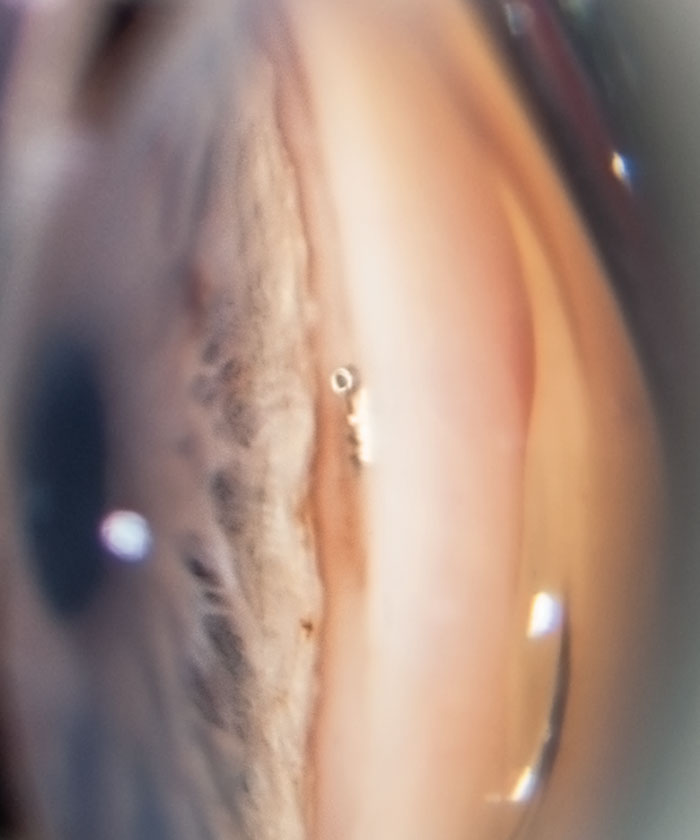 |
|
Over the last decade, iStent has emerged as the predominant glaucoma surgery for Medicare and Medicaid patients, accounting for almost 50% of glaucoma procedures in 2021. Photo: Anthony Van Alstine, OD, MS, and James M. Caruso, OD. Click image to enlarge. |
Over the years, there has been a shift in surgical techniques in glaucoma treatment in the United States, with the emergence of minimally invasive glaucoma surgeries (MIGS) as an alternative to traditional procedures. Understanding the trends in glaucoma surgeries is essential for assessing the impact of these advancements and optimizing patient care. To help provide insights into the evolving landscape of glaucoma treatment, a team of researchers recently performed a comprehensive analysis of glaucoma surgeries in the United States from 2011 to 2021 using data from the Centers for Medicare and Medicaid Services Part B National Summary database. Their findings were presented last week at ARVO in Seattle.
Using CPT codes, researchers identified relevant cases of glaucoma surgeries including trabeculectomy, glaucoma drainage implants and various MIGS procedures, such as iStent, goniotomy, endocyclophotocoagulation, CyPass, Ab externo shunts, transluminal dilation and XenGel. Next, they conducted linear regression analyses.
The results of the study revealed several key findings regarding the trends in glaucoma surgeries in the United States from 2011 to 2021:
- The total Medicare Part B payment for glaucoma procedures increased significantly from $71.5 million in 2011 to $246.1 million in 2021 (adjusted for inflation to 2021 equivalents).
- The total number of glaucoma surgeries increased by 176.7% over the period, from 80,151 in 2011 to 221,602 in 2021.
- Trabeculectomies experienced a decline of 58.5%, dropping from 32,145 in 2011 to 13,345 in 2021.
- The use of glaucoma drainage implants showed fluctuation over the years. It increased from 17,848 in 2011 to 21,323 in 2013, then declined to 17,337 in 2021.
- The iStent became surgeons’ go-to MIGS procedure during the study period. From negligible numbers in 2011 when it was still investigational (just 42 procedures in the CMS database) prior to launch in 2012, volume grew to 103,601 in 2021; by then, it accounted for 46.8% of all glaucoma procedures.
- The number of goniotomies climbed slowly at first and then shot up, from 95 in 2011 to 249 in 2015, finally reaching a level of 38,159 goniotomies by 2021, when it comprised 17.2% of total glaucoma procedures.
- The use of transluminal dilation increased by 7,544%, from 399 cases in 2011 to 30,540 in 2021.
- Ab externo shunts initially declined (from 9,947 in 2011 to 3,973 in 2018) but ultimately increased to 11,531 in 2021.
- Endocyclophotocoagulation was all but eliminated as a viable option during the period, experiencing a significant decrease of over 94% from 19,675 in 2011 to 1,158 in 2021.
“iStent has emerged as the predominant procedure for glaucoma among Medicare recipients, accounting for almost 50% of glaucoma surgeries in 2021,” the researchers noted in their ARVO abstract. They also pointed out, “There was a significant decline in trabeculectomies, contrasting with the stable numbers of glaucoma drainage implants,” and “goniotomies and transluminal dilations had substantial increases over the study period.”
Overall, this research demonstrates the increasing adoption of minimally invasive techniques by glaucoma surgeons in the US, the study authors concluded. “This shift is indicative of advancements in medical technology and a deeper understanding of effective glaucoma treatments,” they wrote.
Original abstract content @2024 Association for Research in Vision and Ophthalmology.
Jayaram RH, Maheshwari A, Sarrafpour S, Liu J, Teng C. Trends for glaucoma surgeries in the United States from 2011 and 2021 – a national study. ARVO 2024 annual meeting. |

